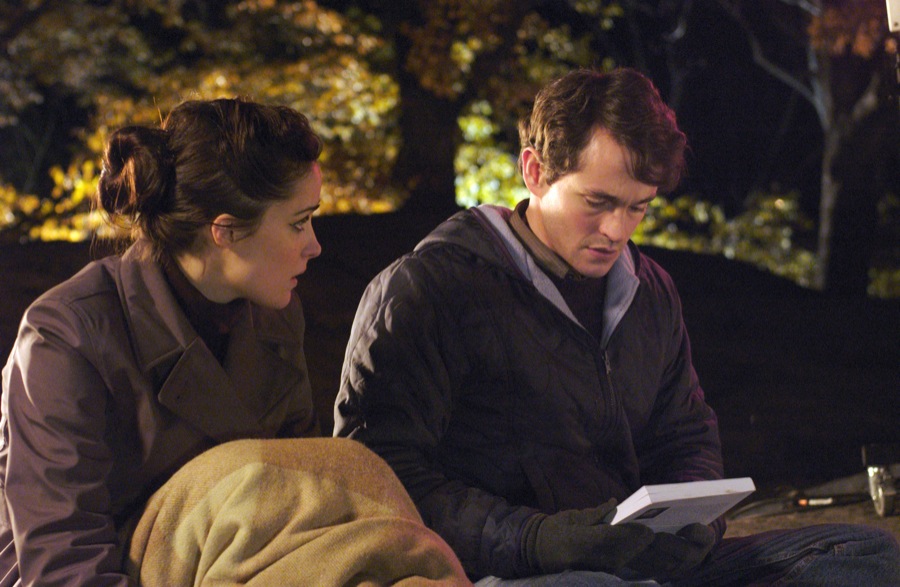8. Niagara, Niagara (1997)

The film tells the story of Marcy, a young woman who suffers from Tourette syndrome, and Seth, and the development of their relationship throughout shoplifting and their trip to Canada. They soon get involved in a young and rebellious romance, creating a world distant from intolerance and affliction.
The syndrome is depicted thoroughly in the film in an outstanding performance by Robin Tunney, and is shown as a neuropsychiatric disorder beginning in childhood. The multiple motor and vocal tics are characteristic in this syndrome, possibly being chronic (persistent) tics.
The autoimmune processes may be essential to the exacerbation of tics in some cases, and environmental, psychosocial and post-infectious factors may have a relevant impact in its severity. The mechanism that is mostly responsible for the tics observed in the syndrome is a dysfunction in the cortical and subcortical regions of the brains, in addition to the regions of the basal ganglia and the frontal cortex. The neuroanatomical studies point to failures in the circuits that connect the regions mentioned above.
Although there is no cure for the syndrome, there are diverse treatments, especially medication, that help control the tics and diminish the effects it has on the person’s everyday life. This biological treatment is depicted in the film, for Marcie is seen searching for and taking that could control her tics, but her deviant personality does not help her actually treat the tics.
“Niagara, Niagara” is not a tale of young love. It is a tale about “not fitting in” and escaping the “cruel” reality that condemns behaviours such as of Marcie (her Tourette’s, which force her to express some eccentric and violent reactions) and of Seth (his “outsider” position regarding others, for example, the shoplifting). They make such an uncommon couple that Marcie’s syndrome does not seem so idiosyncratic.
9. Memento (2000)

This Christopher Nolan film represents a distinguished case of anterograde amnesia; the inability to create new memories, even though the long-term memory might not be affected. People who suffer from this amnesia tend to repeat actions and comments several times and fail to distinguish people they just met.
The story is told following two different lines of narration: one chronologically arranged (black and white scenes) and the other depicted backwards (coloured scenes). Leonard Shelby is a man who suffers this specific type of amnesia and is trying to find one of the attackers who murdered his wife and damaged his brain, altering his declarative memory.
The damage happened in the area of the hippocampus and the medial temporal lobes of the brain, the area that manages short-term memories. The hippocampus is responsible for acting as a sort of a bridge for new information to transform into permanent memories. Therefore, Leonard soon forgets the new information (after crossing a door, for example) but can keep some of the old memories.
Leonard’s anterograde amnesia helps create the perfect atmosphere for the thriller Nolan proposed for the film, increasing the suspense and the mystery involving the characters’ past (or present, depending on the sequence of the scenes).
10. A Beautiful Mind (2001)

This award-winning film depicted the famous American mathematician and Nobel laureate John Nash, focusing on the development of his paranoid schizophrenia. In the story, Nash’s condition is exposed after the audience experiences Nash’s hallucinations and delusions. He and his wife Alicia are not prepared for the impact the illness could bring to the life of a renowned mathematician and the difficult treatments available at the time.
Schizophrenia was (and still is) misunderstood, especially the paranoid subtype, leading to prejudices and difficulties in the acceptance of the treatments. The collateral effects of the medications often led to the repudiation of the treatments, depicted in the film when Nash rejects insulin shock therapy after he became sluggish and impassive, which later increased his hallucinations.
Paranoid schizophrenia is a chronic mental illness defined by the loss of touch with reality, being able to create one of their own. The positive symptoms are often delusions (in Nash’s case, a delusion of grandeur), auditory and visual hallucinations and perceptual disturbances, having a large negative effect on a person’s quality of life.
The causes are associated with chemical imbalance in the brain’s neurotransmitters (especially dopamine and serotonin) responsible for the transportation of information from one neuron to the other.
The effects of this illness are fairly depicted in “A Beautiful Mind”, especially when regarding the treatment’s effects and the consequences of rejecting it. Russell Crowe portrayed a troubled man by the hallucinations of characters he thought were real people, and the life he had to bear after the diagnosis.
11. I Am Sam (2001)

Sean Penn plays Sam Dawson, a man with an intellectual disability and a single father of Lucy, a 7-year-old girl who appears more cognitively developed than her father. Aside from his disability, Sam is well adjusted and is part of a group of supporting and caring partners. Sam, along successful lawyer Rita Harrison, tries to ensure his parental rights over Lucy.
The film follows the relationship between Sam and his daughter and the prejudices they have to suffer from people who cannot comprehend his special situation.
ID is a neurodevelopmental condition regarded by significantly reduced intellect and adaptive behaviour, both affecting the everyday lives on the matters of mental functioning and functional skills. It is a disability aggregated into syndromic intellectual disability because of the focus on the difficulties of performing a normal behaviour, similar to Down syndrome.
Although “I Am Sam” was not highly acclaimed, with critics even questioning the veracity of Penn’s acting, it surely brings important questioning into a prejudiced and intolerant society about the unconventional people, the “exceptional”, and the place they should have in society, in this case regarding parenting rights.
Penn breaks some barriers concerning judicial intolerance against the mentally disabled, which regard them as incapable of sustaining themselves, instead of helping them achieve rights that help them find a place and serve as rightful citizens.
12. 50 First Dates (2004)

This romantic comedy tells the story of Lucy Whitmore and Henry Roth as they start an intimate connection. Henry is a veterinarian working at a sea park in Hawaii, who meets Lucy after a boating incident. He soon acknowledges that Lucy cannot hold any memory after she sleeps, because of a car accident she suffered the year before.
Although Henry is a ladies man and does not show any interest in engaging in a serious relationship, he looks for Lucy and quickly becomes a part of her sad and repetitive life.
Lucy suffers from anterograde amnesia, in which the person loses the declarative memory (the conscious recollection of facts and vocabulary), but being able to keep the procedural memory (the capacity of learning skills or habits). This condition is a product of a brain injury in the region of the hippocampus or the temporal lobe, exactly what happened to Lucy after her car accident.
Henry does not give up on Lucy and starts recording a video, explaining her accident to her as well as their relationship and keeping track of what happened since, similar to a diary.
When Lucy decides it is best to separate and let Henry live his life without this burden, she moves to an institute specializing in neuropsychology and builds a life there. Henry meets her there, but she obviously does not recognize him. She starts dreaming about him and painting pictures of him, which proves that her emotional memory is still intact, even though she can no longer recollect events.
13. Adam (2009)

Adam Raki is a thirtysomething man living alone and working for a toy company in New York. Although there is no clear statement, the audience notices the idiosyncrasy of his character. Adam has Asperger syndrome, an autism spectrum disorder. Asperger’s symptoms are of the spectre of social interactions, with difficulties in keeping social connections and interpreting nonverbal communication.
Besides the difficulties, people with Asperger’s show repetitive patterns of behaviour and intense interests; Adam’s knowledge of the universe is an example. It also preserves the cognitive and linguistic developments, differing from the other disorders on the spectrum.
Asperger’s is apparently a result of developmental factors affecting most of the brain’s systems, but there are no known specific causes to this syndrome (although there are possible mechanisms that separate it from the other ASDs). Neurological studies pointed to the brain alteration, due to abnormal migration of embryonic cells after conception as the reason for the alteration of neuronal circuits controlling behaviours.
Adam perfectly depicts a character who lives daily with this social impairment, as some would reckon. Adam, when interacting with Beth, shows his anxieties and difficulties when dealing with others and interpreting their reactions. Adam’s complications arise when they start a romantic relationship and Beth’s incomprehension sets them apart.
The film does not try to build a canonical romantic story, but a real and emotional tale of a man with Asperger’s and the problems he goes through as he meets conventional and different people.
14. Still Alice (2014)

The film depicts the diagnosis of familial Alzheimer’s disease in Alice Howland, a 50-year-old linguistics professor at Columbia University, after she forgets the word “lexicon” while giving a lecture.
The familial Alzheimer’s, or early-onset Alzheimer’s, is the clinical term for the cases of AD in patients under 65, characterizing an uncommon occurrence. Alice struggles with her progressive loss of memory and of her self-esteem, as she even planned a suicide attempt when she would not remember who she was anymore.
Alice’s reaction to her diagnosis comes from the fact that Alzheimer’s disease is the leading cause of dementia and is usually fatal within 10 years of the first signs. The progression of the disease leaves the patient often unable to perform complex activities, depending therefore on full-time attention and care, as it is seen at the end of the film.
The AD occurs because of deposits of amyloids (insoluble fibrous protein) in some sections of the brain tissue, which form uncharacteristic plaques and neurofibrillary tangles due to mutation of the genes. Some rare genes that can cause Alzheimer’s can be inherited and the offspring tend to develop the disease between their 30s and 50s. This is a reality shown in “Still Alice” when Alice’s sons test for the disease and receive positive results.
15. The Theory Of Everything (2014)

This film tells the story of the famous physicist and cosmologist Stephen Hawking and the progression of his unknown neurodegenerative disease. It focuses on the struggles Jane Hawking had to go through to support Stephen and his impressive work in this new field of science. Although the film does not give much information about the disease itself, it is interesting to follow such moving story.
ALS, amyotrophic lateral sclerosis, is a progressive neurodegenerative disease that attacks the nerve cells in the brain and the spinal cord. Stephen starts to show the symptoms (diminished mobility, because the motor neurons die and the brain loses the ability to initiate and control muscle movement) in his 20s, and after the diagnosis, the doctors give him two years to live, because ALS was then an unfamiliar disease, and no treatments were developed at the time.
Stephen still lives today, contrary to the prediction of the doctors of the time. Although there are no definite causes, the possibilities include gene mutation, chemical imbalance, disorganized immune response and protein mishandling, none of which are mentioned in the picture.
“The Theory of Everything” is an emotional and special film about personal strength and development, especially regarding the care of others, so vulnerable and neglected by the government’s social services.
Author Bio: Viviane Papis is a psychology student. She developed a very special relationship with cinema and storytelling in the process of growing up. Although she tried following the filmmaking career, she realized her passion was writing and scriptwriting.